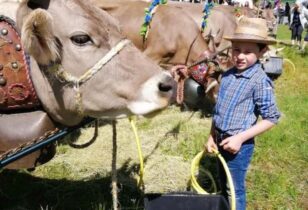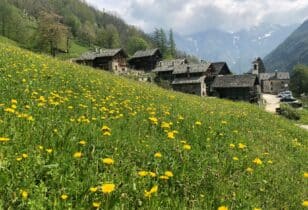Home / Experiences / Picnic Areas Alagna Valsesia
15 new picnic areas equipped with comfortable tables with free and open access to experience the mountains in complete freedom.
And for those who want to taste the specialties of the area can find picnic menus at the bars, restaurants, groceries, farms and mountain huts listed below.
Near the picnic areas you will find fountains where you can refuel with water; don't forget to bring your water bottle… and above all ALWAYS remember all WASTE downstream!
THE RICH MEADOW Grafenboden m. 2231
Time: 2 hours. Path: 207 °
Once you reach Acqua Bianca by shuttle, the route begins on the historic military mule path. After a few minutes, once you meet the crossroads for the Pastore refuge, keep to the right following path no. 207a for the Turlo pass. You walk in a larch forest until you reach the alpine meadows. After about an hour you touch the Mittlentail alp. After crossing the Rio Testanera and the Brunnenwasser you reach Mittlentail beyond. Shortly after alpe in d’Ekku, Faller and then about half an hour Grafenboden.
This pasture opens like an amphitheater towards the valley and in late spring offers an expanse of alpine flora, perhaps also for this reason the Walser had called it GrafenBoden or noble meadow!
A BALCONY ON M.ROSA Alpe Testanera/fum Schworze Haupt – m. 2260
Time: 2.20 hours Path: 207a - 207d
Once you reach Acqua Bianca by shuttle, the route begins on the historic military mule track. After a few minutes, having met the crossroads for the Pastore refuge, keep to the right taking path no. 207a for the Turlo pass. You walk in a larch forest until you reach the alpine meadows. After about an hour, near Alpe Mittlentheil on this side, here is the path no. 207d for Alpe Testanera and its small stretch of water.
We are in the heart of the Alta Valsesia Natural Park! The view of Monte Rosa and the Sesia valley from here is majestic. Not infrequently to enjoy it there are also marmots and ibex.
A MOUNTAIN STOP Alpe Mittlentail/ im enundre Mittlentail – m. 1928
Time: 1.15 hours Path: 207a
Once you reach Acqua Bianca by shuttle, the route begins on the historic military mule track. After a few minutes, having met the crossroads for the Pastore refuge, keep to the right taking path no. 207a for the Turlo pass. You walk in a larch forest until you reach the alpine meadows. After about an hour you touch the Mittlentail alp here. After crossing the Rio Testanera and the Brunnenwasser you reach Mittlentail beyond.
This pasture, located right on the mule track, is the ideal place for a stop for those who have as their destination the Colle del Turlo but also for shorter walks
TWIN LARCH – m 1751
Time: min 50 Path: 207a
Once you reach Acqua Bianca by shuttle, the route begins on the historic military mule track. After a few minutes, having met the crossroads for the Pastore refuge, keep to the right taking path no. 207a for the Turlo pass. After a few hairpin bends inside the larch forest you will arrive at the twin larch.
This is an evocative place that offers encounters with ibex in spring ... .., and, nearby, legends tell us about wild witch dances
GLACIERS TRAKS Alpe Bors/ im Bours – m 1892
Time: 1.15 hours Path: 206-210
Once you have reached the Acqua Bianca locality by shuttle, you walk along the path that starts from the square. After a few minutes you will find the junction for the Pastore refuge on the left and take it. Here a series of steps quickly gain altitude up to the Sesia boiler. Cross the Sesia River on a covered bridge. Arriving at Alpe Pile where the Pastore refuge is located, continue on path no. 206 which goes up the valley looking at Monte Rosa. You arrive at Casera Lungo and continuing straight on you cross the Bors stream. A little further on, leaving trail no. 206, take no. 210 on the left which, uphill, accompanies along the suspended valley of Bors up to the alp. Shortly before arrival you can see the entrance to the gold mine of San Maurizio.
This path coincides with the glaciological path on which we find an extraordinary concentration of glacial evidence. Traces of the passage of glaciers over the centuries and millennia such as: boilers, potholes of the giants, mountain rocks, suspended valleys and glacial cirques!
IN FRONT OF MONTE ROSA Alpe Casera lunga/ Zam Lenge Gode – m. 1634
Time: 35 min - Path: 206
Once you have reached the Acqua Bianca locality by shuttle, you walk along the path that starts from the square. After a few minutes you will find the junction for the Pastore refuge on the left and take it. Here a series of steps quickly gain altitude up to the Sesia boiler. Cross the Sesia River on a covered bridge. Arriving at Alpe Pile where the Pastore refuge is located, continue on path no. 206 which goes up the valley looking at Monte Rosa. You soon arrive in the beautiful meadow of Casera long.
A soft meadow nestled in the plain below Monte Rosa where cows and goats enjoy the new grass in spring.
THE PRISONS AND THE GOLD Località sull’alto poggio/fum Hibeli hei – m 1622
Time: min 50 - Path: 205
It starts from the hamlet of Bonda, next to the departure of the cable cars, in the center of which the path to the hamlet of Dosso begins. From here on a paved road you reach, a little further on, the hamlet of Piane and then follow itinerary no. 205 on the forest service road until you cross the bridge over the Olen stream. Leave this path on the left, continue on the dirt road following the no. 205 (5F) and then take the right. From here you can almost always walk on level ground up to the path that goes down to the right to the locality of Hibeli Hei.
This mid-season mountain pasture .. Not far away was the building of Santa Maria, now in ruins, used as a dormitory for the miners employed in the Kreas gold mines. It was located at about 1700 m and inside there was direct access to the mine galleries. It seems that, for a certain period, the building was used as a prison and the inmates sentenced to work in the mine.
SOFIA E TSCHAFFERLIE Alpe Campo – im oubre Kamp – m 1923
Time: 1.45 hours - Path: 209
The path starts where the carriage road of the Pedemonte hamlet ends, leaving immediately afterwards the path no. 208 to the left for the Mud hill. The itinerary skirts the hamlet of Ronco, arrives at lower Wittwosma and then upper Wittwosma. In constant ascent it reaches the lower and upper Campo Alp.
The effort of the walk is amply rewarded by the view of Monte Rosa and the valley. Just beyond the houses, a small lake acts as a mirror for the surrounding mountains. Sofia (the marmot) and Tschafferlje (the mischievous elf) are watching you!
THE FOUNTAIN BODMER Hamlet Piane/Fum d’boudma – m 1380
Time: 35 min - Path: 205
From the hamlet of Bonda di Alagna (cableway departure area) take path no. 205 which leads to the hamlet of Dosso. From here, following the carriage road, you reach the hamlet of Piane, and enter the houses until you reach the fountain.
The hamlet gave the Christmases to the Bodmer brothers, counted among the extraordinary Prismellese masters (Presmell, locality of Gemelle stones) who during the Renaissance left many examples of their art in the Valais!
WALSER VILLAGE Otro – in Olter – hamlets Dorf and Feglierc/Feljeretsch 1640 m
Time: 1.10 hours - Path: 203
After climbing the steps of Unione Alagnese, take the paved path to the left until you reach the Riale hamlet and cross it without forks. Once you come out on a small paved road, you will see the start of path no. 203 for the Val d’Otro.
The itinerary starts off smoothly and then faces a staircase and continues on a beautiful mule track that is constantly uphill but not excessive. After about 45 min you will find a fork that indicates the detour to the manganese mines. Going straight on you come out of the wood to come out on the great plain of Otro.
Following the path you will discover the hamlets of the valley one by one. The perfection of Walser houses blends harmoniously with the surrounding nature
THE PARK OF THE SHEPHERDS Loc. Shennine – frazione Balma
Time: min 20 - Path: cycle path between Alagna and Riva Valdobbia
Starting from the center of Alagna, walk along the Sesia river downhill to the bridge that crosses it. Move to the orographic left and follow the cycle path for about 20 minutes to the hamlet of Balma, destination of this itinerary.
The toponym In d’Shennine means beautiful places in the Walser language. The origin of the name therefore describes this area between Alagna and Riva Valdobbia better than many words.
THE SNACK OF ‘900 Loc. San d’Ot – Riva Valdobbia
Time: 25 min - Path: 208 to the crossroads, then follow the signs
After crossing the Gallo bridge in Riva Valdobbia, take path no. 208 which begins with a steep climb. Once in the woods, after a short while, you leave the main path to follow the signs that show the detour to the Sas d’Ot, on the left.
This scenic location was once frequented by elegant ladies in long dresses who went here for informal outdoor lunches organized during their summer holidays in the early 1900s. Curious now to enter the beautiful forest, arrive at Sa d’Ot and imagine such a different reality.
ALPINE PASTURE Valle Vogna – Alpe Selletto – m. 1537
Time: 25 min - Path: Path of art
The path starts from the oratory of the Sant'Antonio hamlet. The first section climbs softly while in the second part, before the hamlet of Rabernardo, the slope becomes steeper. After crossing the nucleus of houses, passing by the Walser museum and the fractional fountain, continue across the meadows until you reach the solitary house of Selletto.
It is located on a spur overlooking the valley, an isolated wooden Walser building with mixed architecture. The building is in fact divided into two: a house part and the other raised barn-barn on the "legs". If the path of the high hamlets leads to a suspended world, Selletto could be defined as “suspended among the suspended ones”.
IN THE SHADOW OF SAN GRATO Valle Vogna – Fraz. Peccia – m. 1510
Time: 40 min - Dirt road and then path 201
Departure from the hamlet of Sant’Antonio, where the paved road ends. From here we start on foot on a dirt road between floors and climbs that lead to the hamlet of Peccia announced by a small but pretty artificial lake. Now the dirt road becomes a path that, after crossing the group of Walser houses, becomes a little steeper and reaches the Oratory dedicated to San Grato.
Located on a rocky hill, it dominates this stretch of the valley and protects it from atmospheric events. In the meadow next to it you can see mighty walls, they are what remains of a probable sanitary cordon wanted by the community of the Vogna valley to stop infected cattle coming from the upper part of the valley and from the Aosta Valley during the seventeenth century.
THE BRIDGE OF ELEPHANTS Valle Vogna –Ponte Napoleonico – fraz Peccia m 1530
Time: min 50 - dirt road and then path 201
Departure from the hamlet of Sant’Antonio, where the paved road ends. From here we start on foot on a dirt road between floors and climbs that lead to the hamlet of Peccia announced by a small but pretty artificial lake. Now the dirt road becomes a path that, after crossing the group of Walser houses, becomes a little steeper and reaches the Oratory dedicated to San Grato. The route continues flat up to the Napoleonic bridge.
The bridge was built when the Napoleonic troops entered from Colle Valdobbia in 1800 and occupied the Valsesia. But what does Napoleon have to do with elephants? A legend tells that Hannibal with his army of elephants passed right here!





